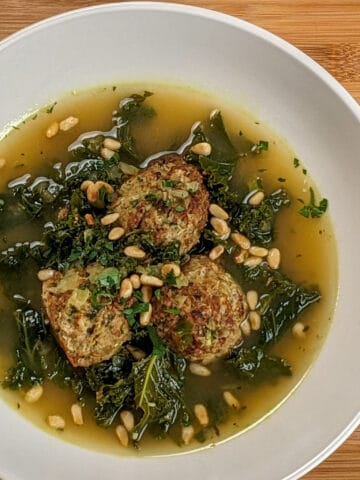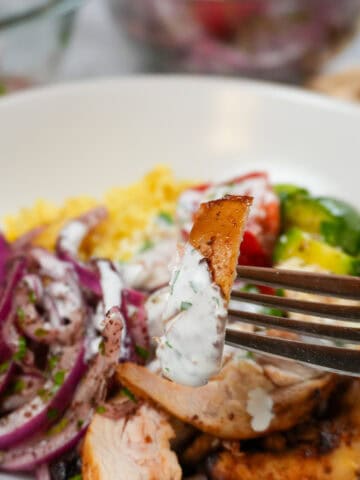Harissa, a red pepper paste with fire-roasted bell peppers, chilies, tomatoes, garlic, and lemon with North African Spices, all done in one shot in the food processor.

Jump to:
At-Home Convenience: Homemade Harissa Paste
This quick Harissa-inspired sauce is made with ingredients you are more likely to find in your home in the US, so that means less time on the road and more at home.
Also, If you like making homemade sauces, try Quick Zhug Sauce - A peppery cilantro parsley sauce inspired by the Yemen Middle-Eastern spicy paste. Additionally, flavors include garlic, caraway, cardamom, coriander, and cumin.
This harissa sauce goes excellent on salmon, chicken burgers, vegetables, and eggs. It is also used in my Spicy Chicken Burger with Harissa Eggplant, Portabella Mushrooms and Onions, and Roasted Harissa Salmon with Paprika Potatoes and Brussel Sprouts recipes. Harissa for breakfast? Of course, try the Harissa Egg Toast with Feta Cheese and Olive Oil; it is so delicious. But it doesn't end there; I also use it in my Harissa Carrot Salad. What a crunch!

Mason Jars are a Gem
These air-tight Ball Glass Pint Regular Mouth Mason Jars keep your harissa fresh longer. Another reason to use glass jars is when making sauces that include tomatoes and red bell peppers. Additionally, you don’t have to worry about staining like plastic containers.
Ingredients and Instructions
As you can see, not much is needed to make this fantastic harissa spice blend recipe. To begin with, drain well a cup of fire-roasted red bell peppers and blend it with crushed red chili flakes, tomato paste, garlic, caraway powder, coriander, cumin, smoked paprika, salt, black pepper, lemon zest, lemon juice, and olive oil. Voila!
See the harissa recipe card for quantities.

Super Simple Sauce

Combine all ingredients in a food processor, like my KitchenAid 3.5 Cup Food Chopper, to create a paste.
Busy Folks - Become a better home cook with cooking tips to help you cook more efficiently on Cook's Notebook tab. Learn about prepping sweet peppers.
Substitutions
- Chili Pepper Flakes - 2 Thai chili, Bird's Eye Chili, or ¼ teaspoon ground cayenne pepper for every teaspoon.
- Fire-Roasted Red Bell Pepper - Try grilling or broiling fresh red bell peppers. See the Frequently Asked Questions for instructions.
Change Heat Level - Modify the harissa recipe's heat level to your liking and learn more about the Scoville Scale and Chili Pairings.
Equipment
- Food Processor - I suggest using a food processor because this will be more of a paste than a sauce. In addition, for this harissa recipe, I use a small food processor, the KitchenAid 3.5 Cup Food Chopper, to quickly make a small batch.
- Zester - Used to zest the lemon to enhance the flavor of the lemon pepper dish. I've also used a Microplane Classic Zester Grater for over two decades, plus any recipe that suggests testing; you might see me using it in my videos. Additionally, it's a great tool to have. It can also grate ginger, hard cheeses, and garlic.
Kitchen Must Haves - Find other tools I use here.
Storage
- Store the harissa in the refrigerator in an air-tight jar or container. This fresh sauce will last for up to 5 days.
Air Tight Food Containers - I use Glass Food Storage Containers with a plastic clipping lid to store food. For example, I always suggest glass storage containers since you can microwave them and hold food without staining the container, and the glass keeps them at a more stable temperature, which keeps the food fresher longer.
Cooking Tips!
- Zesting - It’s good to have a bowl or a plastic cutting board underneath to help catch these delicate little strands, and don’t forget to tap the zest to release some extra from the tool. Remember, you only shave the yellow skin; when you see white, stop because the white part tends to be bitter. I also use the Microplane Classic Zester Grater, which has lasted over a decade.
- Removing Seeds to Control Heat Level - If you use Thai chilies, you can deseed to control the heat. When a recipe calls to deseed hot peppers to maintain the heat level, you must remove the rib, also known as the pith, the white flesh of the pepper.
- Usage - Try as a marinade to grill/ bake/ roast tofu, meats, poultry, fish, and vegetables or as a dipping sauce with hummus or pepper condiment.
Frequently Asked Questions
Use on fish. First, season it with salt and pepper, smear on the paste, and place it in the oven to roast. You can also massage it on chicken and throw it on the grill or use it to spice up your side dishes, like harissa carrot salad. You can also use it to make harissa hummus.
Harissa is a spicy North African chili pepper sauce. It is pounded into a paste, hence its name, which means “to pound” in Arabic, which has gained global popularity in recent years. Additionally, its unique blend of flavors and heat makes it an ideal condiment for dishes ranging from couscous to roasted vegetables.
It originated from the Maghreb, Northwest Africa, primarily from Tunisia, although many variations have developed throughout the region. The Maghreb comprises Arabic countries and territories such as Marocco, Tunisia, Libya, Algeria, Mauritania, and the Sahrawi Arab Democratic Republic.
Some make it super spicy, and some have a little kick. Its taste combines savory, smokey, and peppery paste-like sauce with a hint of spices in the background. Harissa recipes vary greatly, but most typically include red peppers, garlic, coriander, cumin, caraway seeds, olive oil, salt, and sometimes tomatoes or other ingredients such as lemon juice or honey.
If made in the Maghreb region, more than likely, they will use Baklouti, a pepper from that region. In addition, This pepper is smoked, pounded into a paste, and mixed with garlic, cumin, caraway, coriander, and olive oil.
The Scoville scale also classifies harissa as medium-hot to hot depending on the type and quantity of chilis used. Despite its spiciness, harissa remains incredibly versatile and can easily adjust according to individual preferences.
In addition, experienced chefs often combine spices and herbs to create their signature versions. You will also likely find this paste at your local Middle-Eastern, African, Mediterranean, Halal, and Kosher markets. Additionally, I’ve even noticed it now at Trader Joe’s.
Both of these are spicy pepper pastes but come from different regions. For example, Zhug is a green hot pepper paste from Yemen in the Middle East, and Harissa, a red hot pepper paste, is from the Maghreb region in North Africa.
Harissa traditionally uses Baklouti peppers, while zhug uses hot green chilies. Unfortunately, I couldn’t find the pepper name used in Yemen. In addition, if you know, please leave a comment. But most recipes will call for Jalapenos or Serrano chilies. Check out my quick zhug sauce recipe!
Zesting is peeling only the skin of the citrus fruit without the white flesh, referred to as pith. In fact, the skin contains aromatic oils and is an excellent addition to recipes to intensify the flavors of a dish.
In addition, a fine grater is the most convenient way to obtain the zest of the citrus fruit, usually referred to as zester or a Microplane. Learn More at Cook's Notebook: Zesting.
To begin with, Preheat the grill. Then, place whole bell peppers on a heated grill. Allow it to char and blister (about 1 to 2 minutes) on each side of the bell pepper. Once 80% covered in char. Then, remove from the heat, immediately place in a glass or metal bowl, and cover with plastic wrap.
Next, allow it to steam in the bowl for 2 to 3 minutes. This will help release the charred skin from the pulp of the bell peppers. Then, remove the plastic wrap, peel the charred skin, and discard. The peppers might still be hot, and you might want to use tongs or gloves. Finally, cut the bell pepper in half and remove the seeds, stem, and white ribs.
Use the oven broiler setting (Preheat and Use at Medium Heat to 450 degrees). Afterward, place the bell peppers on a roasting rack and sheet pan, and put the pan on the middle rack of the oven. Rotate the bell peppers when charred on one side (about 2 to 3 minutes).
Once 80% is covered in char, remove it from the oven, place it in a metal or glass bowl, and cover it with plastic wrap. Allow sitting for 2 to 3 minutes to allow the steam to separate from the skin. Then, remove the plastic wrap and peel the skin off. Discard charred skin. Finally, cut the peppers in half and remove the seeds, white ribs, and stem.
Not actually. When a recipe calls to deseed hot peppers to control the heat level, you must remove the rib, pith, white flesh of the pepper, which holds most of the capsaicin oils.
North African-Inspired Recipes
Looking for other North African-inspired recipes like this? Try these:
- Grilled Zhug Ras El Hanout Lamb Chops and Tomato Salad
- Spicy Greek Chicken Meatball Rice Bowl
- Easy and Healthy Spicy Turkey Meatball Kale Soup
- Quick and Easy Lean Baharat Spiced Bean and Lamb Stew
Recipes with Harissa Sauce
Looking for other spicy recipes like this? Try these:
- Easy Spicy Italian Chicken Sausage Soup with Farro
- Spicy Chicken Vegetable Stew with Harissa Tomato Sauce
- Spicy Chicken Burger with Harissa Eggplant, Portabella Mushrooms, and Onions
- Harissa Egg & Toast with Feta Cheese and Olive Oil
Video
SUBSCRIBE: 👈To my YouTube Channel to Get Notifications of New Videos.
📖 Recipe
Quick Harissa Sauce
Ingredients
- 1 cup fire-roasted red bell peppers
- 1 teaspoon crushed chili pepper flakes
- 1 tablespoon tomato paste
- 2 garlic cloves
- ⅛ teaspoon caraway powder
- ¼ teaspoon coriander powder
- 1 teaspoon cumin powder
- 1 teaspoon smoked paprika powder
- ¼ teaspoon kosher salt
- ¼ teaspoon ground black pepper
- ½ lemon zested and juiced
- 2 tablespoons extra virgin olive oil
Equipment
Instructions
- Save time in the kitchen: Read the instructions thoroughly, then gather and prep all your ingredients before cooking! Learn Prepping Tips.
- Note: If you use canned or jarred fire-roasted red bell peppers, discard the excess liquid by draining it well with a sieve.
- Blend: In a food processor, add the fire-roasted red bell peppers, chili flakes, tomato paste, garlic, caraway powder, coriander, cumin, paprika, salt, ground black pepper, lemon juice, lemon zest, and olive oil.
- Blend into a thick, smooth consistency, scrapping along the way with a silicone spatula.
- Store: Use as needed and store the rest in an air-tight glass jar or container. It should last up to 5 days in the refrigerator or even longer.
Video
Nutrition
Food safety
- Cook chicken to a minimum temperature of 165 °F (74 °C).
- Do not use the same utensils on cooked food that previously touched raw meat to prevent foodborne illness from contaminated uncooked meats.
- Wash hands after touching raw meat to prevent cross-contamination.
- Don't leave food at room temperature for extended periods; this can breed bacteria.
- Never leave cooking food unattended to prevent burns and fires.
- Use oils with a high smoke point to avoid harmful compounds.
- Always have good ventilation when using a gas stove to prevent carbon monoxide poisoning.
- See more guidelines at USDA.gov.
Have a Question or Comment?
If you have a question or comment about this harissa recipe, please post it below. You will definitely get a quick response. It also helps our other readers to stay informed. Thanks!














Leave a Reply